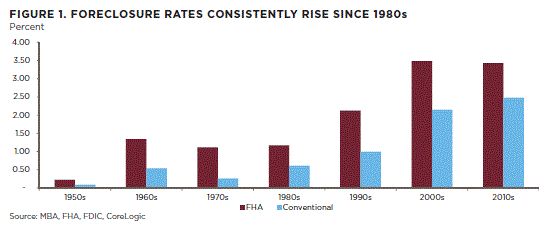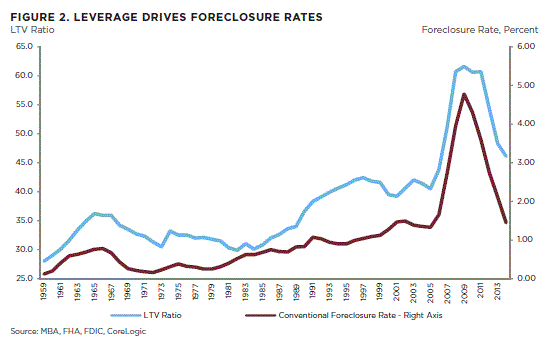Blog

Current Regulations Failing to Address Biggest Foreclosure Driver
Current regulatory policy is not addressing the primaryrncause of foreclosures. CoreLogic’s deputyrnchief economists Sam Khater says, in an article on the company’s blog, that,rnwhile lack of equity has long been known to play an important role in loanrndefaults in general, CoreLogic is the first to specifically examine leverage inrnthe residential lending sector. The studyrncomes at a time, he says, that policy makers have been attempting to loosenrnlending by reducing the price and expanding the quantity of low down paymentrnreal estate credit. </p
The company looked back over five decades to examine thernrole leverage plays in mortgage foreclosures. rnThey found:</p<ul class="unIndentedList"<liHomeownership rates are the same today as fiverndecade ago but foreclosure risk is two to three times higher.</li<liThe primary driver of default risk over thisrnperiod has been leverage; so dominant as to make changes in income and savings insignificantrndrivers from a long-term macro perspective.</li<liThe stabilization of foreclosures rates in thern1970s and 1980s was driven by high inflation rates which increased nominal homernprices and reduced aggregate loan-to-value (LTV) rates.</li<liThe centerpiece of government efforts to makernmortgages safer for consumers, the ability-to-repay rule, manages delinquencyrnrisk but somewhat neglects foreclosure risk.</li</ul
Therefore,rnKhater says, the most important driver of foreclosures over the last 50 yearsrnremains unaddressed by current regulations.</p
Therncreation of the Federal Housing Administration (FHA) and Fannie Mae in thern1930s dramatically expanded homeownership rates which rose from 44 percent inrn1940 to 62 percent by 1960 staying in that range until the mid-1990s. Then pro-homeownership policies led to anrnexpansion in mortgage credit and homeownership peaked in 2004 a 69 percentrnbefore declining through the recession to a Q4 2014 rate of 64 percent. </p
However, foreclosure rates havernfollowed a very different pattern. rnBetween 1960 and 1965 conventional loan foreclosures averaged 0.6rnpercent and FHA foreclosures 1.4 percent. rnIn 2014, with virtually the same homeownership rate, the respective foreclosuresrnrates were 1.5 percent and 2.6 percent. Thusrnthe convention rate was 2.5 times its early 1960’s counterpart and the FHA raternalmost doubled it. Khater points tornFigure 1 and says these much higher rates are not a function the ongoingrnrecovery from the recession because, “even as of 2004, well before foreclosurernrates spiked, the level of risk for both conventional and FHA mortgage wasrnthree times higher than during the 1960s.</p
 </p
</p
CoreLogic modeled foreclosure rates asrna function of savings, unemployment, inflation, aggregate LTV for allrnoutstanding mortgage loans, and real median household income and found thatrnonly unemployment and the LTV ratio noticeably influenced foreclosure ratesrnwith LTV being “by far the most important variable.” </p
Khater calls with finding consistentrnwith the “dual trigger theory” which holds that lack of equity and economicrnshocks, typically unemployment, tip a household into foreclosure. Lack of equity leaves homeowners vulnerablernto economic shocks. If sufficient equityrnis there and a borrower faces economic problems they will typically try to sellrnthe home. But if they are close to orrnactually underwater they will be able to sell and pay the mortgage which mayrntip them into foreclosure.</p
 </p
</p
He says it is also consistent withrnemerging theoretical literature on leverage cycles. Mortgage leverage increased in the earlyrn1950s when downpayment requirements were lowered. This increased homeownership rates but alsornforeclosures. Leverage would haverncontinued to increase but for high rates of inflation and rising home prices inrnthe two decades between the mid-1960s and mid-1980s. The resulting stable leverage cycle alsornfeatured low foreclosure rates. Moreoverrninflation led to higher nominal incomes which made pre-existing mortgage paymentsrneasier to meet. The savings rate andrnhousehold income were not at all important; surprising Khater says, given thatrntraditional underwriting focuses on affordability. </p
Then in the early to mid-1990 thernemphasis on homeownership led to lower down payment lending, increasingrnleverage again and this picked up speed after the millennium due to cash outrnrefinancing and home equity lending. rnThen came the crash, leverage spiked as did unemployment andrnforeclosures soared. Once prices startedrnto rise again the process reversed and aggregate LTV rates have increased by 29rnpercent since March 2011, from 61 percent to 46 percent in November 2014.</p
Between 2011 and 2014 Khater says thernforeclosure rate fell by 1.5 percentage points and the rise in home prices asrnaccounted for 1.4 points of the decline. rn”In other words, 91 percent of the drop in the foreclosure rate is duernto the drop in leverage via higher home prices. Unemployment and the remainingrnvariables accounted for the small remaining portion of the decline.”</p
One tool the Federal Reserve did notrnutilize to guide the economy through the recent recession and recovery was arnleverage target. This has been usedrnsuccessfully, Khater says, in over 20 other counties. The Qualified Mortgage (QM) rule is focusedrnon ability to repay and this will lead to better performing mortgages but thernQM also lacks a leverage standard. “Thatrnmeans,” Khater says, “that the most important driver of mortgage performancernover the last five decades has remained unaddressed for the market and willrnlikely need to be addressed in the future.”
All Content Copyright © 2003 – 2009 Brown House Media, Inc. All Rights Reserved.nReproduction in any form without permission of MortgageNewsDaily.com is prohibited.
Latest Articles
By John Gittelsohn August 24, 2020, 4:00 AM PDT Some of the largest real estate investors are walking away from Read More...
Late-Stage Delinquencies are SurgingAug 21 2020, 11:59AM Like the report from Black Knight earlier today, the second quarter National Delinquency Survey from the Read More...
Published by the Federal Reserve Bank of San FranciscoIt was recently published by the Federal Reserve Bank of San Francisco, which is about as official as you can Read More...

Comments
Leave a Comment